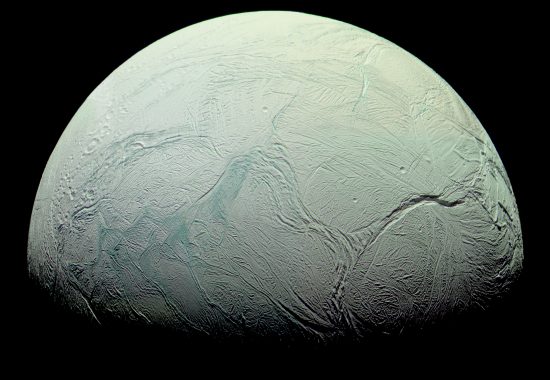
Initially believed to be just a regional water body on the South Pole of Enceladus, the source of fine spray of water vapor, icy particles and organic molecules is in fact a major ocean covering the entire moon, a new study has suggested.
Studying the tiny wobbles of Saturn’s moon, researchers at Cornell University and SETI have showed how they have come to the conclusion that beneath the icy crust of Enceladus lies a huge ocean.
Using data collected by NASA’s Cassini spacecraft, researchers studied the moon’s very slight wobble, as it orbits Saturn. They say that the wobbles can only be accounted for in case where the outer ice shell is not connected to the rocky core or any part of the interior – something that suggests that there is a global ocean between the shell and the core of the moon.
Presence of water has already been suggested in previous studies, but that was said to have been present in the south polar region, but in depth investigation of gravity data from Cassini sheds a whole new light on the moon’s geology suggesting that the possibility of global ocean are higher than a regional one.
“This was a hard problem that required years of observations, and calculations involving a diverse collection of disciplines, but we are confident we finally got it right,” said Peter Thomas, a Cassini imaging team member at Cornell University, Ithaca, New York, and lead author of the paper.
Cassini scientists analyzed more than seven years’ worth of images of Enceladus taken by the spacecraft, which has been orbiting Saturn since mid-2004. They carefully mapped the positions of features on Enceladus — mostly craters — across hundreds of images, in order to measure changes in the moon’s rotation with extreme precision.
As a result, they found Enceladus has a tiny, but measurable wobble as it orbits Saturn. Because the icy moon is not perfectly spherical — and because it goes slightly faster and slower during different portions of its orbit around Saturn — the giant planet subtly rocks Enceladus back and forth as it rotates.
The team plugged their measurement of the wobble into different models for how Enceladus might be arranged on the inside, including ones in which the moon was frozen from surface to core.
“If the surface and core were rigidly connected, the core would provide so much dead weight the wobble would be far smaller than we observe it to be,” said Matthew Tiscareno, a Cassini participating scientist at the SETI Institute, Mountain View, California, and a co-author of the paper. “This proves that there must be a global layer of liquid separating the surface from the core.”
The mechanisms that might have prevented Enceladus’ ocean from freezing remain a mystery. Thomas and colleagues suggest a few ideas for future study that might help resolve the question, including the surprising possibility that tidal forces due to Saturn’s gravity could be generating much more heat within Enceladus than previously thought.

“This is a major step beyond what we understood about this moon before, and it demonstrates the kind of deep-dive discoveries we can make with long-lived orbiter missions to other planets,” said co-author Carolyn Porco, Cassini imaging team lead at Space Science Institute, Boulder, Colorado, and visiting scholar at the University of California, Berkeley. “Cassini has been exemplary in this regard.”
The research is presented in a paper published online in the journal Icarus.
Alexa Mason is the blogger behind Single Moms Income, a personal finance freelance writer, and an online entrepreneur. Come hang out with her on Facebook and Pinterest.
Comments